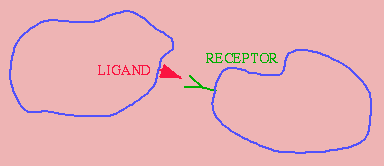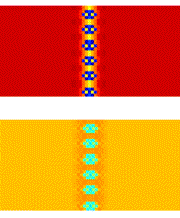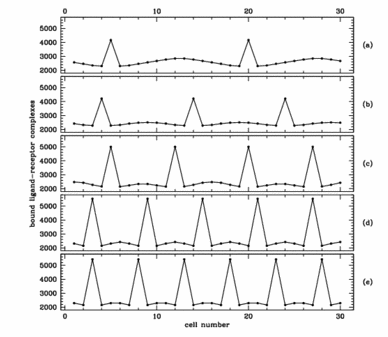Jonathan A. Sherratt, Department of Mathematics, Heriot-Watt University
Developmental Patterning via Juxtacrine Signalling
Biological Background
 Many established models for developmental pattern formation involve a
chemical signalling molecule (ligand) diffusing within the extracellular
environment, and binding to receptors on the cell surface, thereby
altering their behaviour. However, over the last decade, it has been
realised that a number of signalling molecules involved in early
development are actually bound to the cell membrane, rather than
diffusing in extracellular space. This type of signalling is known
as "juxatcrine", and occurs in tissues whose cells are closely packed,
such as the epithelia in which many early patterns are laid down.
Many established models for developmental pattern formation involve a
chemical signalling molecule (ligand) diffusing within the extracellular
environment, and binding to receptors on the cell surface, thereby
altering their behaviour. However, over the last decade, it has been
realised that a number of signalling molecules involved in early
development are actually bound to the cell membrane, rather than
diffusing in extracellular space. This type of signalling is known
as "juxatcrine", and occurs in tissues whose cells are closely packed,
such as the epithelia in which many early patterns are laid down.
Pattern Formation
 The patterning potential of juxtacrine signalling depends on the way
in which binding of ligand to receptor feeds back into the system.
Markus Owen, Helen Wearing and I have studied the case of positive
feedback: i.e. binding causes
increased production of ligand and receptor. Intuitively one might
think that this would lead to spatial uniformity, but in fact this
"lateral induction" can produce patterns, of wavelengths varying from
2 to 15 (and possible more) cell lengths.
The patterning potential of juxtacrine signalling depends on the way
in which binding of ligand to receptor feeds back into the system.
Markus Owen, Helen Wearing and I have studied the case of positive
feedback: i.e. binding causes
increased production of ligand and receptor. Intuitively one might
think that this would lead to spatial uniformity, but in fact this
"lateral induction" can produce patterns, of wavelengths varying from
2 to 15 (and possible more) cell lengths.
The figure shows the evolution of patterns from a small initial
perturbation of a uniform equilibrium, in a 60x30 grid of cells.
Two cases are shown, with different parameters, one giving a spotted
pattern and the other giving a striped pattern.
The plots show unoccupied receptor numer (blue=low, red=high), and
there are corresponding patterns in ligand and bound receptors.
Our work shows that juxtacrine patterning with positive feedback
represents a new mechanism for spatial pattern formation in early development.
Mathematical analysis of the patterns
 Helen Wearing, Markus Owen and I performed a detailed study of patterning
in a juxtacrine cell signalling model in one space dimension using
linear stability analysis. We showed that patterns form when there is
weak feedback in ligand production and moderate feedback in the
production of new receptors. Moreover the analysis made predictions
concerning pattern selection, and the sequence of patterns shown in
the figure was obtained by using feedback levels predicted in this
way. However there is a significant discrepancy between the
predictions of the linear analysis and the results of numerical
simulations. In one region of parameter space, the linear analysis
predicts the formation of patterns of wavelength 2, i.e. cells
alternating with high and low ligand/receptor levels. But numerical
simulations reveal patterns of wavelength 4. Helen Wearing and I
investigated this using a combination of nonlinear analysis and a
numerical bifurcation study. This showed that the wavelength 2 pattern
does exist but is unstable, with the wavelength 4 pattern being
stable. More generally, the nonlinear analysis gives a detailed
picture of the pattern forming potential of juxtacrine signalling.
Helen Wearing, Markus Owen and I performed a detailed study of patterning
in a juxtacrine cell signalling model in one space dimension using
linear stability analysis. We showed that patterns form when there is
weak feedback in ligand production and moderate feedback in the
production of new receptors. Moreover the analysis made predictions
concerning pattern selection, and the sequence of patterns shown in
the figure was obtained by using feedback levels predicted in this
way. However there is a significant discrepancy between the
predictions of the linear analysis and the results of numerical
simulations. In one region of parameter space, the linear analysis
predicts the formation of patterns of wavelength 2, i.e. cells
alternating with high and low ligand/receptor levels. But numerical
simulations reveal patterns of wavelength 4. Helen Wearing and I
investigated this using a combination of nonlinear analysis and a
numerical bifurcation study. This showed that the wavelength 2 pattern
does exist but is unstable, with the wavelength 4 pattern being
stable. More generally, the nonlinear analysis gives a detailed
picture of the pattern forming potential of juxtacrine signalling.
The work described on this page is discussed in the following papers:
-
M.R. Owen, J.A. Sherratt:
Mathematical modelling of juxtacrine cell signalling.
Math. Biosci. 153: 125-150 (1998).
Click to see the
 Full paper (PDF)
Full paper (PDF)
-
M.R. Owen, J.A. Sherratt, S.R. Myers:
How far can a juxtacrine signal travel?
Proc. R. Soc. Lond. B 266: 579-585 (1999).
Click to see the
 Full paper (PDF)
Full paper (PDF)
-
M.R. Owen, J.A. Sherratt, H.J. Wearing:
Lateral induction by juxtacrine signalling is a new mechanism for
pattern formation.
Dev. Biol. 217: 54-61 (2000).
Click to see the
 Full paper (PDF)
Full paper (PDF)
-
H.J. Wearing, M.R. Owen, J.A. Sherratt:
Mathematical modelling of juxtacrine patterning.
Bull. Math. Biol. 62: 293-320 (2000).
Click to see the
 Full paper (PDF)
Full paper (PDF)
-
H.J. Wearing, M.R. Owen, J.A. Sherratt:
Mathematical modelling of juxtacrine patterning.
Bull. Math. Biol. 62: 293-320 (2000).
Click to see the
 Full paper (PDF)
Full paper (PDF)
-
H.J. Wearing, J.A. Sherratt:
Nonlinear analysis of juxtacrine patterns.
SIAM J. Appl. Math. 62, 283-309 (2001).
Click to see the
 Full paper (PDF)
Full paper (PDF)
Back to Jonathan Sherratt's Research Interests
Back to Jonathan Sherratt's Home Page
 The patterning potential of juxtacrine signalling depends on the way
in which binding of ligand to receptor feeds back into the system.
Markus Owen, Helen Wearing and I have studied the case of positive
feedback: i.e. binding causes
increased production of ligand and receptor. Intuitively one might
think that this would lead to spatial uniformity, but in fact this
"lateral induction" can produce patterns, of wavelengths varying from
2 to 15 (and possible more) cell lengths.
The patterning potential of juxtacrine signalling depends on the way
in which binding of ligand to receptor feeds back into the system.
Markus Owen, Helen Wearing and I have studied the case of positive
feedback: i.e. binding causes
increased production of ligand and receptor. Intuitively one might
think that this would lead to spatial uniformity, but in fact this
"lateral induction" can produce patterns, of wavelengths varying from
2 to 15 (and possible more) cell lengths.
 Many established models for developmental pattern formation involve a
chemical signalling molecule (ligand) diffusing within the extracellular
environment, and binding to receptors on the cell surface, thereby
altering their behaviour. However, over the last decade, it has been
realised that a number of signalling molecules involved in early
development are actually bound to the cell membrane, rather than
diffusing in extracellular space. This type of signalling is known
as "juxatcrine", and occurs in tissues whose cells are closely packed,
such as the epithelia in which many early patterns are laid down.
Many established models for developmental pattern formation involve a
chemical signalling molecule (ligand) diffusing within the extracellular
environment, and binding to receptors on the cell surface, thereby
altering their behaviour. However, over the last decade, it has been
realised that a number of signalling molecules involved in early
development are actually bound to the cell membrane, rather than
diffusing in extracellular space. This type of signalling is known
as "juxatcrine", and occurs in tissues whose cells are closely packed,
such as the epithelia in which many early patterns are laid down.
 Helen Wearing, Markus Owen and I performed a detailed study of patterning
in a juxtacrine cell signalling model in one space dimension using
linear stability analysis. We showed that patterns form when there is
weak feedback in ligand production and moderate feedback in the
production of new receptors. Moreover the analysis made predictions
concerning pattern selection, and the sequence of patterns shown in
the figure was obtained by using feedback levels predicted in this
way. However there is a significant discrepancy between the
predictions of the linear analysis and the results of numerical
simulations. In one region of parameter space, the linear analysis
predicts the formation of patterns of wavelength 2, i.e. cells
alternating with high and low ligand/receptor levels. But numerical
simulations reveal patterns of wavelength 4. Helen Wearing and I
investigated this using a combination of nonlinear analysis and a
numerical bifurcation study. This showed that the wavelength 2 pattern
does exist but is unstable, with the wavelength 4 pattern being
stable. More generally, the nonlinear analysis gives a detailed
picture of the pattern forming potential of juxtacrine signalling.
Helen Wearing, Markus Owen and I performed a detailed study of patterning
in a juxtacrine cell signalling model in one space dimension using
linear stability analysis. We showed that patterns form when there is
weak feedback in ligand production and moderate feedback in the
production of new receptors. Moreover the analysis made predictions
concerning pattern selection, and the sequence of patterns shown in
the figure was obtained by using feedback levels predicted in this
way. However there is a significant discrepancy between the
predictions of the linear analysis and the results of numerical
simulations. In one region of parameter space, the linear analysis
predicts the formation of patterns of wavelength 2, i.e. cells
alternating with high and low ligand/receptor levels. But numerical
simulations reveal patterns of wavelength 4. Helen Wearing and I
investigated this using a combination of nonlinear analysis and a
numerical bifurcation study. This showed that the wavelength 2 pattern
does exist but is unstable, with the wavelength 4 pattern being
stable. More generally, the nonlinear analysis gives a detailed
picture of the pattern forming potential of juxtacrine signalling.
 Full paper (PDF)
Full paper (PDF)